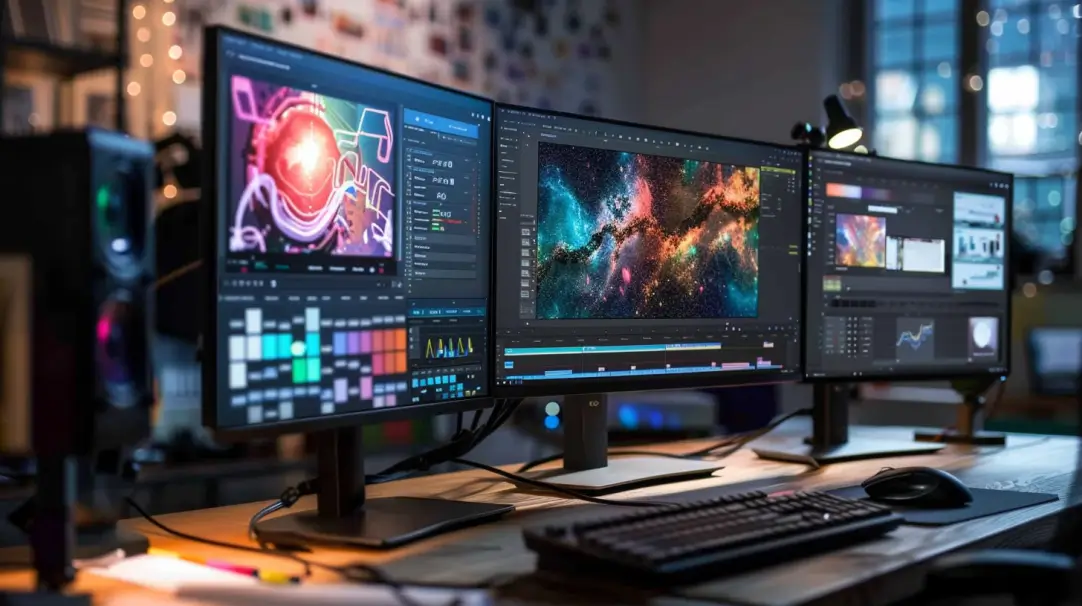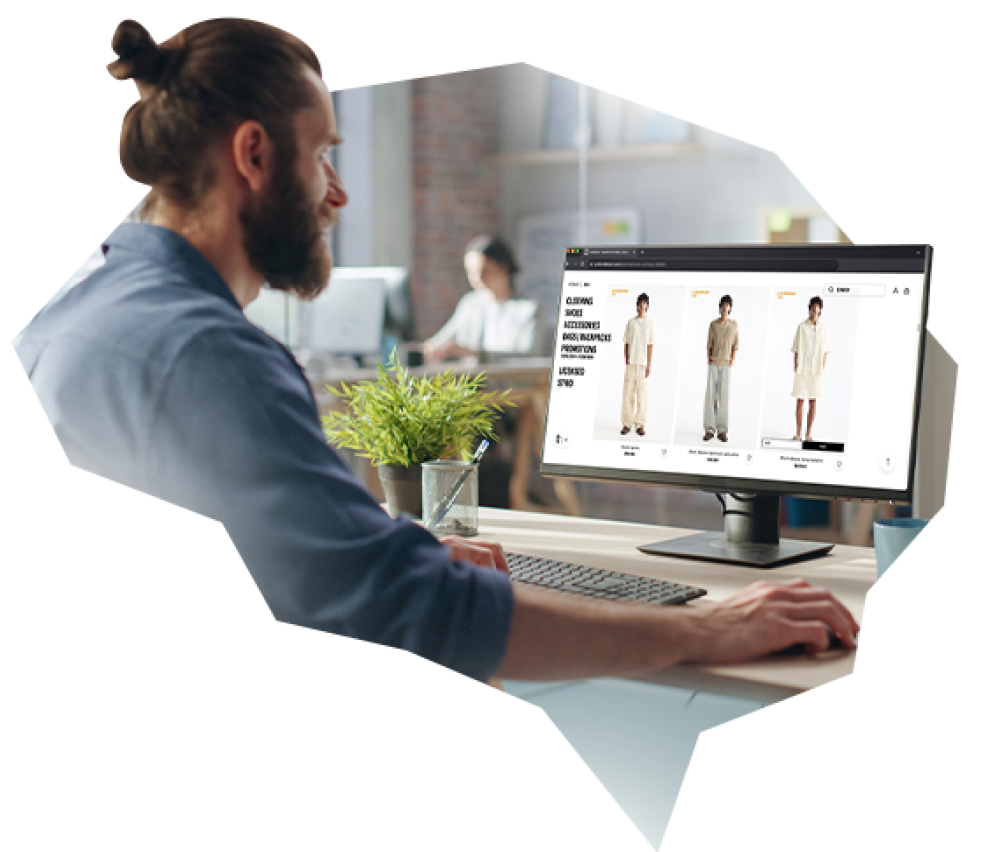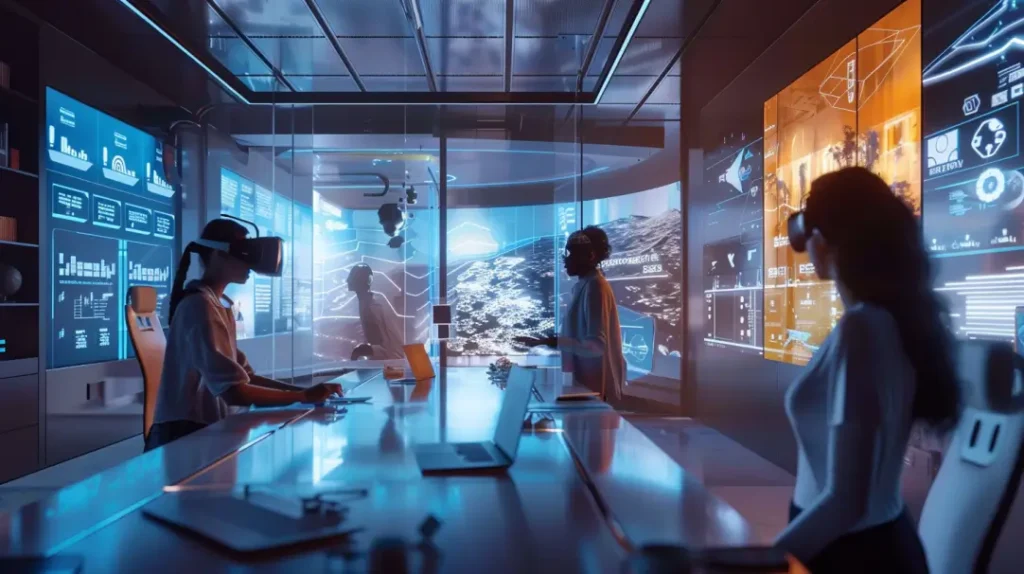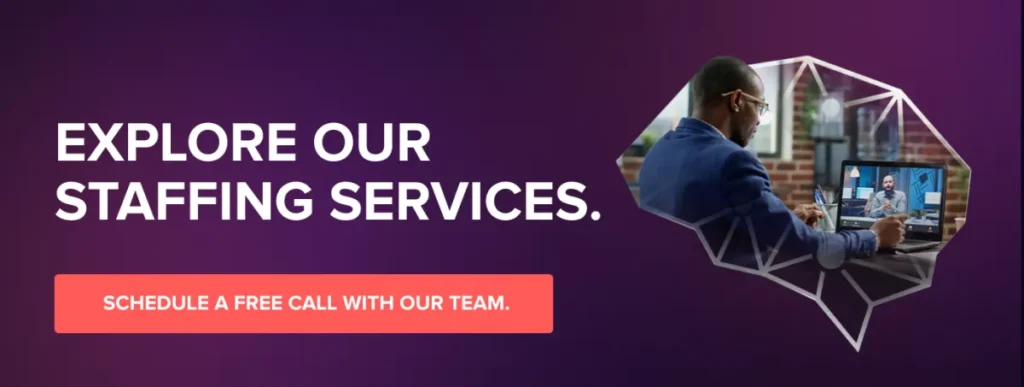Introduction

In the tapestry of today’s digital realm, where the boundary between the virtual and the real blurs, the craft of UI/UX design emerges as the pivotal architect of our digital experiences. Picture this: a staggering 88% of online consumers are less likely to return to a site after a bad experience. This statistic alone underscores the monumental impact that UI/UX design holds over the digital landscapes we navigate daily. It’s not just about aesthetics; it’s about creating digital environments that resonate, engage, and ultimately, convert.
If your goal is to secure the best talent with an impeccable job description for UI/UX designers, look no further. By clicking the link below, you’ll gain immediate access to our exclusive, complimentary job description template. This document embodies the core principles and highest practices of C9Staff’s renowned hiring methodology, providing you with a robust foundation to craft your own hiring specifications. Elevate your recruitment process and attract top-tier UI/UX design talent by leveraging a resource meticulously designed to meet your needs.
UI/UX DESIGNER JOB DESCRIPTION TEMPLATE

As we dig into the world of UI/UX design, we find it to be a realm rich with opportunity and challenge. It’s a world that beckons both the visionary job seeker, eager to carve out a meaningful career, and the discerning employer, in pursuit of the maestros who can translate user needs into seamless digital experiences. The role of a UI/UX designer is nuanced, blending the art of design with the science of usability to craft interfaces that not only look stunning but feel intuitively right.
Our journey through “Mastering the Craft: A Comprehensive Guide to UI/UX Designer Job Descriptions” promises to be an enlightening expedition into the core of digital design roles. From the fundamentals of crafting compelling job descriptions to decoding these blueprints of expectation and opportunity, we will traverse the landscape of UI/UX design together. You’ll gain insights into the pivotal role of UI/UX designers in shaping digital products, learn how to attract or become the talent that leads the industry, and explore the future trajectories of digital design roles.
This guide is an invitation to a conversation that goes beyond the traditional job description. It’s an exploration into the heart of UI/UX design, emphasizing its critical role in creating digital products that enchant, engage, and stand the test of user expectations. Whether you’re a job seeker aiming to navigate the intricacies of the UI/UX design world, or an employer on the quest for talent that can breathe life into your digital visions, you’re in the right place.
Prepare to commence on the most informative journey into the world of UI/UX design job descriptions. Together, we will uncover the essence of designing for the digital age, ensuring that by the end of this guide, you’re not only informed but also inspired to either seek out the best in the field or become the epitome of UI/UX design excellence yourself.
The Heart of UI/UX Design
At the heart of the digital age lies the dynamic and evolving world of UI/UX design—a realm where the aesthetics of digital products meet their functional prowess, crafting experiences that resonate deeply with users across the globe. UI (User Interface) and UX (User Experience) design are the twin pillars that uphold the quality of the digital journey, ensuring that every application, website, or online platform is not only a pleasure to behold but also a breeze to navigate.
UI design focuses on the look and feel of the product, encompassing the color schemes, typography, and layout that dictate its visual appeal. UX design, on the other hand, is all about the overall experience a user has with that product: from ease of use to the satisfaction derived from interaction. Together, these disciplines work in harmony to create digital environments that are not just functional but also psychologically appealing, tapping into the user’s needs, preferences, and emotions.
The journey of UI/UX design has been nothing short of revolutionary. From the clunky interfaces of early computing to the sleek and intuitive designs of today’s smartphones and apps, the field has undergone a radical transformation. This evolution has been driven by a deeper understanding of human-computer interaction, advancements in technology, and a growing recognition of design’s impact on user engagement and business success.
Today, we stand on the brink of new frontiers in digital design. Emerging trends such as AI-driven design, voice user interfaces, and virtual reality are pushing the boundaries of what’s possible, demanding a blend of creativity, technical skill, and psychological insight from the next generation of UI/UX designers.
Leading voices in the field emphasize the importance of empathy in design, advocating for solutions that prioritize user needs and accessibility. “Design is not just what it looks like and feels like. Design is how it works,” Steve Jobs once said, encapsulating the ethos that continues to drive innovation in UI/UX design. This perspective challenges designers to look beyond the surface, considering the myriad ways in which users interact with digital products and how these experiences shape their perception of the brand.
As we delve deeper into the essence of UI/UX design, it becomes clear that this field is not just about creating beautiful interfaces; it’s about understanding the human behind the screen. Whether you’re an aspiring designer, a seasoned professional, or an employer looking to leverage the power of design in your digital offerings, the journey through the world of UI/UX is a journey towards creating more intuitive, engaging, and meaningful digital experiences.
By embracing the principles of UI/UX design, we can transform the digital landscape, making it more accessible, enjoyable, and effective for users everywhere. As we continue to explore this fascinating field, let us be guided by a spirit of innovation, empathy, and a deep commitment to enhancing the human experience in the digital realm.
From Concept to Launch: A Step-by-Step Guide to the UX Design Process Through a Mobile App Project
Crafting the Perfect UI/UX Designer Job Description (Employers’ Perspective)

In the competitive arena of digital innovation, the allure of a job description can be the difference between attracting just another candidate and securing a visionary UI/UX designer who will propel your company into the future. Crafting this beacon begins with understanding the anatomy of an exceptional job description, a task that requires more than just listing requirements; it demands storytelling that resonates with the ambitions and talents of the best in the field.
The Anatomy of an Exceptional Job Description
Job Title Nuances: The job title is the first handshake with potential candidates. “UI/UX Designer” might be straightforward, but nuances like “Senior UI/UX Designer – Shaping the Future of Mobile Experience” can immediately signal the level of expertise you’re seeking and the scope of influence the role holds.
Detailed Responsibilities: Clarity is king. Outline daily tasks and long-term objectives, ensuring candidates can visualize their day-to-day and the impact of their work. Highlight collaborative aspects of the role, showcasing how they will interact with cross-functional teams to create a holistic user experience.
Required Qualifications and Desired Skills: Be specific about the qualifications necessary for the role, differentiating between must-haves and nice-to-haves. This clarity helps candidates self-select based on their fit for the role, ensuring you attract the most qualified applicants. However, flexibility is key; emphasize the value of related experiences that demonstrate transferable skills.
Clarity and Specificity: Each component of the job description should speak directly to the candidate’s aspirations and professional goals. Use language that not only describes the role but also inspires action, painting a vivid picture of the possibilities that lie ahead.
Making Your Job Description Stand Out
Weave in Your Company Culture: Today’s top talent is looking for more than a job; they’re seeking a place where they can grow, contribute to something meaningful, and align with the company’s values. Highlight how your company fosters innovation, supports professional development, and embraces design thinking at all levels.
Highlight Growth Opportunities: Emphasize the pathways available for professional and personal growth within your organization. Whether it’s through leadership opportunities, continuous learning programs, or exposure to cutting-edge projects, show how the role is a stepping stone to greater achievements.
Showcase the Impact: Illustrate the significant impact of the UI/UX designer role on your organization and its customers. Share success stories or testimonials from current team members about the transformative projects they’ve contributed to, underscoring the tangible results of their work.
Examples of Compelling Job Descriptions
Consider a job description that begins with: “At [Company], we believe in designing experiences that delight users at every touchpoint. As our Senior UI/UX Designer, you’ll be at the forefront of creating intuitive and transformative digital experiences that set the standard for excellence in the industry. You’ll collaborate with a dynamic team of creatives and technologists, driving innovation with each project. If you’re passionate about making a real impact and ready to lead the way in digital design, join us in shaping the future of our digital landscape.”
Such narratives not only list the expectations but also frame the role within the larger mission of the company, appealing to candidates motivated by impact and innovation.
If your goal is to secure the best talent with an impeccable job description for UI/UX designers, look no further. By clicking the link below, you’ll gain immediate access to our exclusive, complimentary job description template. This document embodies the core principles and highest practices of C9Staff’s renowned hiring methodology, providing you with a robust foundation to craft your own hiring specifications. Elevate your recruitment process and attract top-tier UI/UX design talent by leveraging a resource meticulously designed to meet your needs.
UI/UX DESIGNER JOB DESCRIPTION TEMPLATE

Decoding the UI/UX Designer Job Description (Job Seekers’ Perspective)

In the vibrant and ever-evolving world of digital design, the journey to landing your dream UI/UX position can sometimes feel like navigating a maze. With each job description packed with a myriad of requirements, the process can appear daunting. However, hidden within these lists lies a roadmap to your success, a guide that, when decoded, can significantly elevate your job-seeking strategy. As a mentor to aspiring UI/UX designers, my aim is to illuminate this path, transforming complex job descriptions into actionable insights.
Understanding Job Descriptions
At the core of every job listing are the key skills and qualifications sought by employers. Yet, the true essence of what they’re looking for often lies beneath the surface. Beyond the technical competencies and design tools, employers are signaling their values, the team environment, and the overarching goals of their projects. Reading between the lines allows you to understand not just what the job entails, but how it fits within the larger vision of the company. This knowledge is crucial, enabling you to tailor your application to resonate not just with the role, but with the culture and mission of the organization.
Tailoring Your Application
Showcasing Relevant Projects: Your portfolio is a narrative of your professional journey. When aligning it with a job description, highlight projects that mirror the potential employer’s sector, challenges, or target audience. This demonstrates not only your capability but your understanding of their specific needs.
Emphasizing Transferable Skills: Many skills in UI/UX design are transferable. Whether it’s your ability to conduct user research, your expertise in creating wireframes, or your knack for storytelling through design, these skills should be highlighted in the context of what the job description emphasizes.
Adapting Your Narrative: Every company has its language and priorities. Reflect this in your application by using similar terminology and focusing on the parts of your experience that align most closely with their stated goals. This shows that you’re not just a skilled designer, but one that is already in tune with their way of thinking.
Success Stories
Consider Alex, a junior designer with a background in graphic design, who successfully transitioned to a UI/UX role at a leading tech company. By focusing on his transferable skills—such as his keen eye for aesthetics and understanding of user-centric design principles—and aligning his portfolio with the company’s emphasis on innovative mobile experiences, Alex demonstrated his readiness to contribute from day one.
Then there’s Jordan, who leveraged her experience in small startup environments to land a senior position in a company valuing agility and innovation. She highlighted her ability to wear multiple hats, her direct involvement in user testing, and her contributions to rapid product iterations, underscoring her fit with the dynamic nature of her new role.
Empowering Your Journey
As you commence on your job search, remember that each application is an opportunity to demonstrate not only your skills but your alignment with the potential employer’s vision and values. By thoughtfully analyzing job descriptions and customizing your application, you can transform the job-seeking challenge into a journey of discovery and opportunity.
In the world of UI/UX design, where the landscape is as much about innovation as it is about understanding the human element behind every interaction, your ability to decode and align with job descriptions can set you apart. Let this guide be your beacon, illuminating the path to not just any role, but one that truly resonates with your aspirations and talents. The opportunities in the field of UI/UX design are boundless, and with the right approach, your dream role is within reach.
Are you ready to supercharge your career and land your dream job? C9Staff is here to pave the way for your next big opportunity. By clicking the link below and submitting your resume to our talent acquisition department, you’re taking the first step towards discovering how we can help elevate your career. If your qualifications align with our client’s requirements, we’ll reach out to explore potential opportunities that match your profile. Don’t let this chance to make a significant leap in your career pass you by.

Bridging the Gap Between Employers and Candidates

In the intricate dance of recruitment and job searching, particularly within the nuanced field of UI/UX design, the chasm between employers and potential candidates can seem dauntingly wide. Yet, it is not impassable. This section aims to serve as a blueprint for constructing a bridge of understanding and alignment, starting with the cornerstone of any hiring process: the job description.
The Mutual Benefits of Clarity
A well-crafted job description does more than list requirements; it serves as a mirror reflecting an organization’s self-awareness and its respect for candidates’ aspirations. Such clarity not only ensures that applications are from individuals truly aligned with the role’s demands but also communicates the organization’s culture, team dynamics, and the broader goals of the position. This precision in articulating the role’s essence sets the stage for attracting candidates who are not just qualified but are genuinely interested in contributing to the company’s vision.
Fostering Open Communication
The journey from posting a job description to the final selection is pivotal and should be characterized by open communication and feedback. Engaging candidates with updates and acknowledgments throughout the process not only keeps them informed but also builds a positive perception of the company’s brand. Importantly, providing feedback, especially to those not selected, can be invaluable. It’s an opportunity to offer constructive insights that can aid in their professional development, reflecting the company’s commitment to genuine engagement regardless of the outcome.
Consider the example of a candidate who, after not making the cut for a particular role, received detailed feedback from the employer. This guidance became the catalyst for refining their skills, leading to their success in securing a position elsewhere. Such instances underscore the potential of thoughtful feedback to transform an otherwise disheartening experience into a stepping stone for growth.
The Responsibility of Both Parties
The responsibility for ensuring a transparent, respectful, and effective hiring process lies with both employers and candidates. Employers must strive to craft job descriptions that truly capture the essence of the role and maintain an open line of communication throughout the hiring process. Candidates, on the other hand, are encouraged to engage actively with the process, seeking clarity where needed and reflecting on feedback provided.
Building Relationships
Ultimately, the essence of successful UI/UX design hiring is the cultivation of relationships. From the initial job description to the final handshake (or, in today’s digital world, the final click of the “send” button), each step should be underpinned by clear intentions, mutual respect, and continuous dialogue. This approach not only ensures the alignment of organizational needs with candidates’ skills and aspirations but also fosters a foundation for long-term engagement and collaboration.
By prioritizing clarity in job descriptions, fostering open communication, and encouraging active participation from both sides, employers and candidates can navigate the complexities of the hiring process more effectively. In doing so, they build bridges of understanding that not only span the gap between them but also connect the best of talents with the most visionary of companies in the dynamic field of UI/UX design.
Beyond the Job Description: Fostering a Culture of Growth and Innovation

In the vibrant landscape of UI/UX design, where technology evolves at breakneck speed and user expectations rise, the difference between leading and lagging behind often hinges on one key factor: a steadfast commitment to growth and innovation. This dedication transcends traditional job roles, creating a dynamic ecosystem where both employers and job seekers not only adapt but thrive.
For Employers: Cultivating a Culture of Continuous Learning
The cornerstone of any forward-thinking organization is its recognition of the workforce as its most valuable asset. Investing in the continuous learning and professional development of UI/UX teams is not just a perk but a necessity. This commitment yields manifold benefits, including enhanced team skills, higher morale, increased retention, and a steady stream of innovation feeding the company’s projects and processes.
Embedding professional development into the company culture can take various forms, from hosting regular workshops and sponsoring attendance at industry conferences to providing access to cutting-edge online courses. Such initiatives ensure that teams not only keep pace with the latest design trends and technologies but also feel valued and motivated. A workforce that grows together is more likely to innovate together, pushing the boundaries of what’s possible in UI/UX design.
For Job Seekers: Embracing the Proactive Pursuit of Knowledge
For those looking to carve out a career in UI/UX design, the path is clear: stay curious, stay learning, and stay ahead. The value of proactively seeking out new skills and technologies cannot be overstated. It positions job seekers not just as candidates but as pioneers, ready to contribute fresh perspectives and innovative solutions from day one.
Engaging with the design community, experimenting with new tools, and taking on personal projects are practical ways to embed continuous learning into one’s professional journey. Online platforms and networking events offer rich opportunities for growth, allowing aspiring designers to immerse themselves in the latest industry developments and connect with like-minded professionals.
Success Stories: The Transformative Power of Growth and Innovation
Consider the case of a tech startup that revolutionized its product design process by implementing a bi-weekly innovation day, allowing team members to explore new tools and techniques. This initiative not only led to the development of groundbreaking features but also significantly boosted team morale and retention rates.
On the individual front, there’s the story of a graphic designer who transitioned to a successful career in UI/UX by dedicating evenings and weekends to mastering user research and prototyping tools. Their portfolio, enriched with projects showcasing these new skills, opened doors to opportunities that were previously out of reach.
The Future of UI/UX Design Roles

As we stand on the cusp of the future, the realm of UI/UX design stretches out before us, rich with the promise of innovation and transformation. Emerging trends in technology, shifts in user behavior, and the cross-pollination with other disciplines are crafting a new horizon for digital product design. This evolving landscape beckons UI/UX designers to not only adapt but to lead the charge in redefining the digital experience.
Key Trends Shaping the Future
The integration of augmented reality (AR), voice user interfaces (VUIs), and AI-driven design tools are not just fleeting trends; they are the signposts of our journey forward. These technologies expand the canvas on which designers create, offering new mediums to connect with users in ways that were once the realm of science fiction. Similarly, the growing emphasis on psychological principles and data science in design underscores the shift towards creating more intuitive, human-centered products. This evolution demands a broader skill set from designers, blending technical prowess with deep empathy and analytical insights.
The Evolving Roles of UI/UX Designers
As we navigate these changes, the roles and responsibilities of UI/UX designers are poised for transformation. We anticipate the emergence of new specializations, focusing on AR/VR experience design, voice interaction design, and even AI UX specialists who work closely with machine learning systems to craft adaptive, intelligent user interfaces. This future will also see designers adopting a holistic approach to the user experience, one that transcends screen-based interfaces to encompass multi-sensory, multi-channel interactions.
Implications for Employers and Job Seekers
For employers and job seekers alike, this shifting landscape underscores the importance of adaptability and lifelong learning. Staying ahead means investing in continuous education and fostering a culture that values curiosity and experimentation. It involves seeking out cross-disciplinary collaborations that spark innovation and expand the boundaries of what UI/UX design can achieve.
Employers should prioritize creating environments that encourage learning and exploration, while job seekers must proactively update their skills and embrace the ever-expanding toolkit of the modern designer. Together, these efforts can ensure that the workforce remains agile and capable of harnessing the potential of new technologies and approaches.
If you’re seeking to navigate the complexities of sourcing, recruiting, hiring, training, managing, and deploying the ideal UI/UX designer for your organization, C9Staff extends an invitation to discover how our expertise can align with your needs. Click the link below to schedule a complimentary exploratory call with one of our seasoned account managers. During our conversation, we’ll attentively listen to your requirements, offering endorsements for potential candidates at no cost to help you identify the absolute best talent available, all at competitive prices.

Conclusion
As we reach the culmination of our journey through the multifaceted world of UI/UX design, we reflect on the insights garnered and the path laid out before us. From the nuanced understanding of job roles within the UI/UX domain to the forward gaze into the technological and methodological evolutions shaping its future, this exploration has underscored the imperative of crafting precise job descriptions, the necessity of a profound grasp of the UI/UX landscape, and the reciprocal advantages of perpetual learning and adaptation for both the architect of opportunities—employers, and the navigators of career paths—job seekers.
We’ve uncovered the symbiotic essence that intertwines the crafting of meticulous job descriptions with the successful convergence of organizational demands and the aspirations of candidates. This alignment is crucial, acting as the keystone in building a robust foundation for both entities to thrive within the dynamic realm of UI/UX design. Furthermore, we’ve stressed the importance of keeping pace with the ever-evolving trends, technologies, and methodologies that continually reshape the UI/UX landscape, emphasizing that such knowledge is instrumental in nurturing a culture brimming with innovation and growth.
Now, as we stand at this juncture, let us extend a motivational call to action. To employers: Go beyond merely seeking talent. Be the cultivators of an environment where creativity, curiosity, and the pursuit of technological frontiers are encouraged and celebrated. To job seekers: View each day as an opportunity to broaden your horizon, to embellish your toolkit of skills, and to inch closer to the UI/UX role of your dreams. Let every learning opportunity be the scaffold upon which you build your future in this exhilarating field.
Embrace this call with both inspiration and resolve. Let the knowledge you’ve acquired through these pages empower you to stride confidently into the next phase of your UI/UX journey, armed with the enthusiasm to transcend the ordinary.
As we conclude, remember: the domain of UI/UX design is not just a field of work; it is a battleground of innovation, a canvas for creativity, and a forge for the future of digital experiences. The decisions you make, the paths you choose, and the willingness to embrace change and drive innovation will not only delineate your personal and professional trajectory but also sculpt the digital experiences that define our world.
The future of UI/UX design beckons with open arms, rich with challenges yet abound with opportunities for those daring enough to seize them. Let us march forward, employers and job seekers alike, to shape not just our destinies but the very essence of user experience in the digital age.



